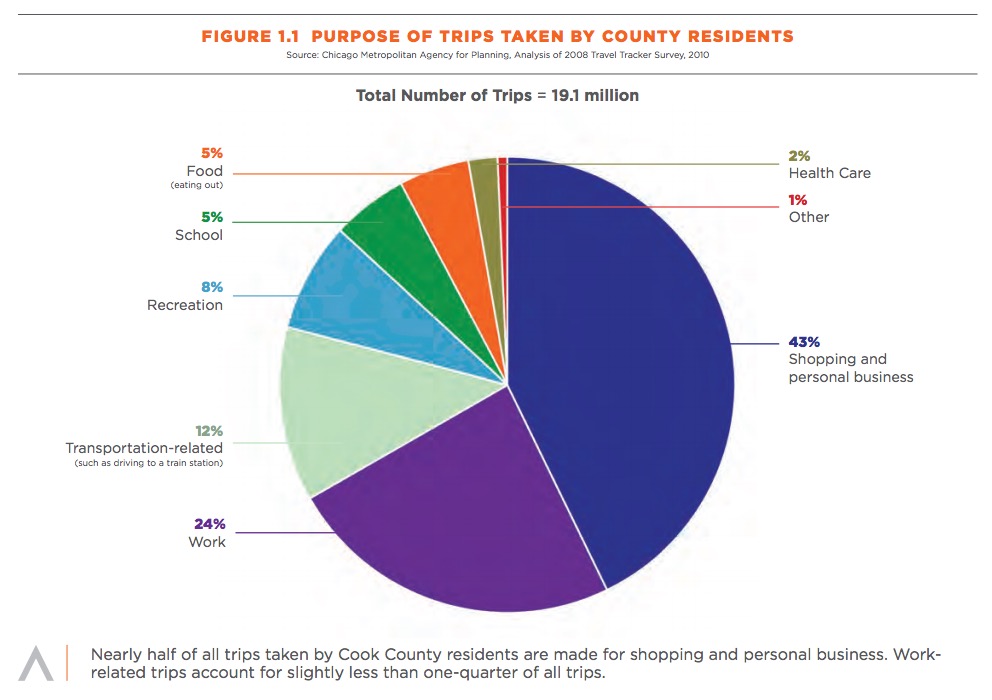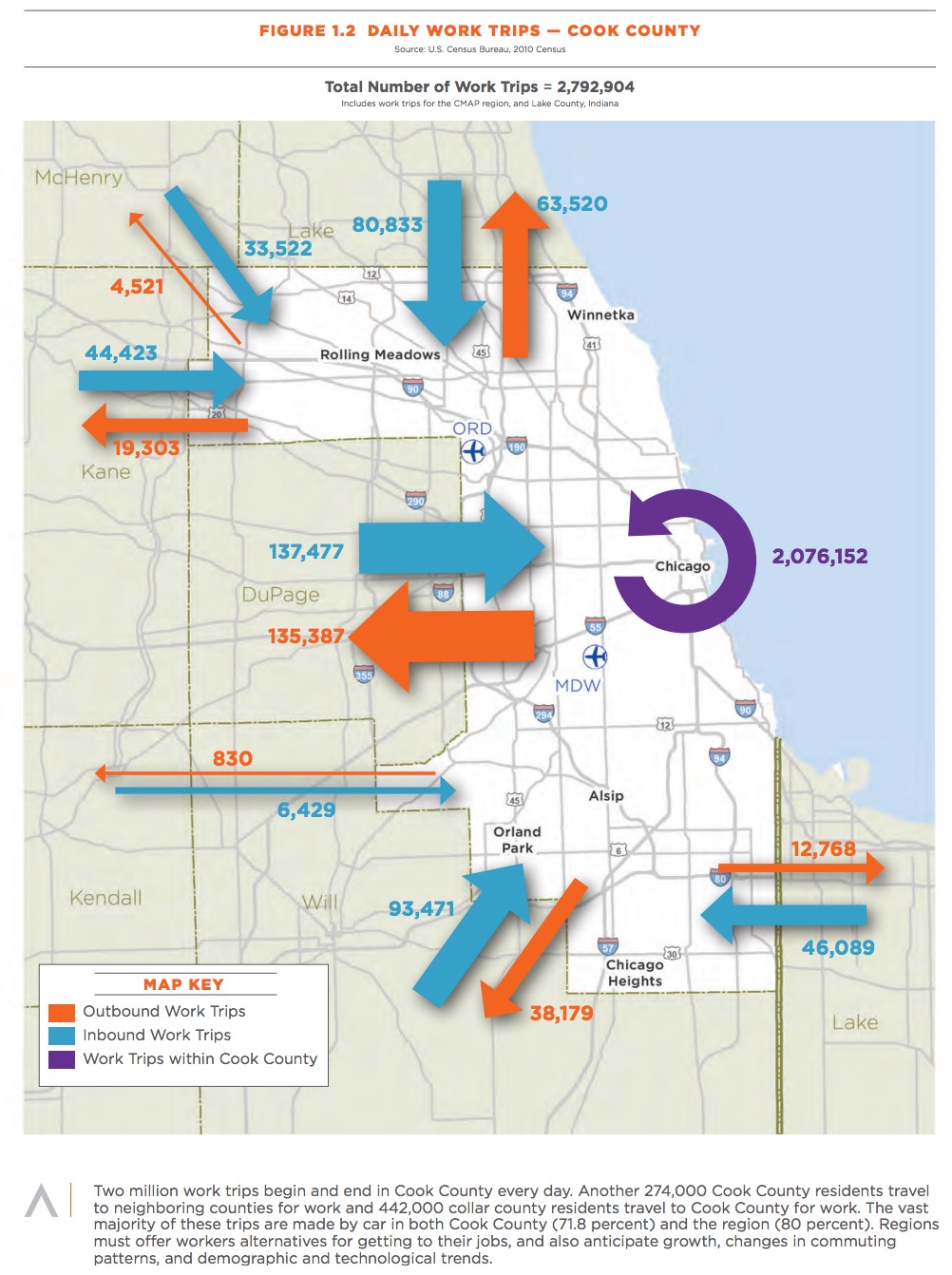COOK COUNTY GOVERNMENT
Chapter One: Cook County’s Transportation Needs
 Cook County’s transportation system is one of its greatest assets, having a central—even dominant—role in the national and international movement of people and goods. As this plan Connecting Cook County will outline, this competitive advantage is being threatened by the actions other regions are taking, as well as the Chicago region’s own limits in confronting significant challenges. Many of these impediments are evident today. Other impediments and opportunities will emerge as new technologies are adopted, as consumers express new preferences, and as the economy continues to transform itself.
Cook County’s transportation system is one of its greatest assets, having a central—even dominant—role in the national and international movement of people and goods. As this plan Connecting Cook County will outline, this competitive advantage is being threatened by the actions other regions are taking, as well as the Chicago region’s own limits in confronting significant challenges. Many of these impediments are evident today. Other impediments and opportunities will emerge as new technologies are adopted, as consumers express new preferences, and as the economy continues to transform itself.
Connecting Cook County provides the framework through which County officials, under the leadership of President Preckwinkle, can plan for the future, advocate for sound transportation policies, and—most importantly—take action.
- The purpose of transportation is to support the economy and create livable communities. Transportation is meant to get workers to work, shoppers to stores, students to school, and products to consumers. Good transportation systems help create stronger economies, reduce transportation costs, and create better, more livable communities.
- Transportation systems are multi-purpose and multi-modal. Airports generate truck and auto traffic. Passenger rail services compete with freight transportation. Cars and trucks share the same highways. The various components have to be designed and managed as an integrated system, rather than as distinct silos.
- The current transportation system involves hundreds of public agencies working with private sector institutions to provide transportation assets and services. Effective transportation planning and management requires intergovernmental cooperation and partnerships with the private sector.
This chapter of Connecting Cook County begins with a description of the users of the transportation system and the reasons they need these services. It then describes the trends that will shape future preferences and alter the way transportation services are delivered.
The Current Need for Transportation Services
Every day Cook County residents use various transportation services to get to work, school, family, and friends. Businesses use it to receive raw materials, ship finished products to customers, or fly across the world to finalize a deal. People and businesses from other areas also depend heavily on the County’s transportation system, whether they are going to work, visiting a museum, or passing through on their way from Indianapolis to Milwaukee. All of these millions of daily trips fulfill some economic or social purpose. The users of the system are looking for the least expensive, most convenient, most reliable, and safest ways to reach their destinations.
Transportation is not an end in itself. It is a means by which people and businesses fulfill their objectives. And yet, agencies responsible for transportation too often report progress in terms of the number of trains run per day, the condition of road pavement, or the miles of bike lanes installed. These measures are important, but the users of the transportation system only care if it will allow them to achieve their goals in a reasonable amount of time, at a reasonable cost, and preferably with multiple options.
Toward those ends, the County’s transportation system serves three interrelated purposes. First, it must support the businesses and families that reside in the County. Second, it must accommodate the demands that come with being the hub of the metropolitan area, including those of commuters from the surrounding counties, regional freight, and visitors wishing to take advantage of all that the region has to offer. Third, the system must perform a crucial function as both the nexus of North American freight distribution and a linchpin of the global freight network. The first and second of these are common to all major urban areas, but Cook County’s transportation system is forced to confront the demands imposed by all three on a daily basis.
Demands from Within the County
Residents
The largest and most obvious source of demand for transportation services within Cook County comes from its residents. As the center of the nation’s third largest metropolitan area, the County is home to nearly two million households and more than five million residents. While it makes up less than a quarter of metropolitan Chicago’s land area, its residents represent roughly sixty percent of the region’s population. Nationally, Cook County is among the densest urban areas and is the second most populous county.
During a 24-hour workday, residents take more than 19 million trips. The peak evening rush hour sees more than one million residents traveling at any given moment, of which less than half of these are commuters coming home from work. Data for the number, purpose, and mode of trips within Cook County and the region comes from the Chicago Metropolitan Agency for Planning (CMAP) 2008 Travel Tracker Survey. More recent data is not available, but the order of magnitude and character of those trips are not likely to have changed materially. Figure 1.1 illustrates the purposes of these various trips.
While the commute to and from work—perhaps the most commonly discussed trip purpose—represents a significant portion of these trips, it is actually surpassed by trips made for shopping and personal business, and nearly matched by trips made for recreation or transportation-related functions. Certainly, residents rely on the transportation system for far more than getting to work. Commuting, though, plays an outsized role in the need for transportation services in two ways. First, the distances and destinations of these commutes matter. The average round-trip for work taken by a Cook County resident ranges from less than 13 miles in central Chicago to nearly 24 miles in the southern suburbs, significantly longer than the average round-trip for other purposes (roughly six to 10 miles, depending on purpose and point of origin). Indeed, while many residents live and work within the County, a large percentage travel significant distances. Hundreds of thousands more commute into a neighboring county each day. Figure 1.2 provides an overview of these patterns.
Download full version (PDF): Connecting Cook County – Long Range Transportation Plan
About the Cook County Government
https://www.cookcountyil.gov
Cook County contains 128 municipalities in its region, the most well known being the City of Chicago – which is the County seat where the central offices of Cook County are located. The City of Chicago and the suburban municipalities account for approximately 85% of the County’s 946 square miles, while unincorporated areas make up the remaining 15%. The unincorporated areas of the County are under the jurisdiction of the Cook County Board of Commissioners…As mandated by State law, County government has principal responsibility for the protection of persons and property, the provision for public health services and the maintenance of County highways.
Tags: Chicago, Cook County, Cook County Government, IL, Illinois, Toni Preckwinkle







 RSS Feed
RSS Feed